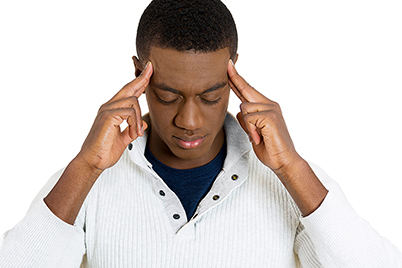
Achelios Presenting Positive Test Results for Migraine Drug
By Barry Teater, NCBiotech Writer
 |
| -- Shutterstock photo |
A potential new topical therapy for the treatment of acute migraine appears safe and effective, according to data that Achelios Therapeutics of Chapel Hill has prepared for presentation at an April 22 neurology conference.
In the report on results of a phase two-a clinical trial comparing the Achelios drug candidate TOPOFEN with placebo, study volunteers who got the active drug experienced greater pain relief faster, with fewer migraine-associated symptoms such as nausea, light and sound hypersensitivity. They also had greater suppression of pain over the 24-hour period they were asked to follow each migraine once they applied the gel to the temple area of their faces, the company says.
Achelios, established in 2012 in Chapel Hill, is a privately held pharmaceutical-development company focused on topical drugs for the treatment of migraine and peripheral pain. It is backed by private capital financing, and its research has been supported in part by a $250,000 Small Business Research Loan awarded in 2013 by the North Carolina Biotechnology Center.
The clinical trial was conducted by scientists from Achelios and the Michigan Headache & Neurological Institute of Ann Arbor, Mich. The results were assembled for presentation at the Emerging Science Session of the American Academy of Neurology’s annual meeting in Washington, D.C.
Promising approach using topical gel for migraine
“The positive results of this study provide preliminary evidence that migraines can be effectively treated topically without the safety and side effects challenges that often accompany systemic oral medications,” said Crist Frangakis, Ph.D., president and CEO of Achelios, the study’s sponsor. “Serious side effects of NSAIDs (nonsteroidal anti-inflammatory drugs), such as stomach bleeding and ulcers, result in more than 100,000 hospitalizations and thousands of deaths each year in the U.S. With TOPOFEN, physicians and patients, especially those with cardiovascular risks, will have a new treatment option.”
TOPOFEN, also known as ELS-M11, is a proprietary gel consisting of 5 percent ketoprofen, a potent NSAID. The gel formulation was developed to permeate human skin rapidly and efficiently.
The randomized, crossover, double-blind, placebo-controlled study involved 48 screened adults with a history of episodic migraine with and without aura (the warning signs that can precede headache pain in about 20 percent of sufferers). Patients were instructed to treat five moderate to severe migraines by applying the TOPOFEN gel on the skin, over the three branches of the trigeminal nerve in the temple area, and to record their symptoms on an electronic diary.
TOPOFEN shows strong benefit over placebo
Of the severe migraine patients, 45 percent had sustained pain relief from 2 to 24 hours compared to 15 percent of placebo. Also 50 percent of patients who treated their severe pain with TOPOFEN were pain free at 24 hours compared to 25 percent of placebo-treated patients. Patients whose severe headaches were treated with TOPOFEN were at least three times as likely to experience complete relief of associated symptoms (nausea and photophobia) versus placebo.
Some patients experienced application-site irritation, mostly mild or moderate. That was the only reported side effect, and it resolved quickly, the company will report.
William R. Bauer M.D., Ph.D., FAAN, a neurologist, migraine headache specialist and advisor to Achelios, said, “Migraine remains a significant global cause of disability and disruption of activities of daily living. TOPOFEN results show promise to provide a safe and effective treatment that will positively impact the disabling effects of such a condition.”
Duke physician reporting results to conference attendees
Wolfgang Liedtke, M.D., Ph.D., of Duke University is to present the results as a member of the team that conducted the research and a paid advisor to Achelios. Liedtke, an associate professor of neurology and attending physician in the Duke Medicine Pain Clinic, said, “The results of the study are encouraging, and those of us who treat migraine think it may lead to a meaningful alternative treatment for a substantial number of migraineurs. This study showed that it may be possible to affect severe migraine, which can be a debilitating neurological pain condition, with a topical application to facial trigeminal nerve endings, which was unexpected.”
Migraines are commonly treated with oral NSAIDs such as aspirin, ibuprofen and naproxen, which have known safety issues and side effects such as gastrointestinal irritation, bleeding and ulcers, especially when used in higher doses that are often required to relieve migraine pain. Topical NSAIDs represent an alternative to the pill form.
Migraine wracks at least 37 million Americans
At least 37 million Americans suffer from migraine, according to the National Headache Foundation. The prevalence of migraine peaks at about 40 years of age and headaches tend to occur in the prime productive years of 25-55. The socio-economic cost burden is estimated to exceed $25 billion annually.
The trigeminal nerve is believed to play a key role in migraines. It is a major pain pathway that supplies all sensory innervation for the head, face and all adjacent sentient structures such as teeth, eyeball, sinuses and, importantly for headaches such as migraine, the dura mater that surrounds the brain. All of these structures can activate pain-sensing trigeminal nerve endings.
Migraine is believed to occur when brain cells trigger the trigeminal nerve to release neuropeptides that enhance inflammation and make the sensitive dura mater hypersensitive. These events cause sharp pain because blood vessels also dilate, affecting the highly sensitized dura and making the pain pulse-synchronous. Migraine headaches are typically on one side of the head and are felt around the eye or temple.
The company’s name, Achelios, is derived from the mythological Greek moon goddess Achelois, which loosely translates as “she who washes away pain.”
